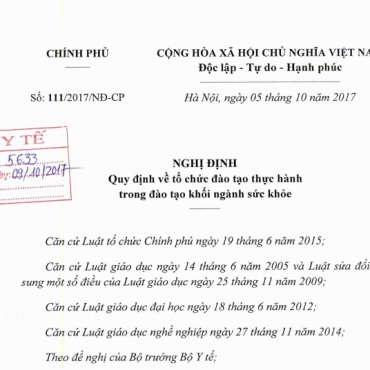Liên hệ tuyển sinh
Hợp tác Quốc tế
Antimicrobial Use in a Cohort of US Nursing Homes, 2017
Antimicrobial Use in a Cohort of US Nursing Homes, 2017
Nicola D. Thompson, MS, PhD1; Nimalie D. Stone, MD1; Cedric J. Brown, MS1; et alAustin R. Penna, MPH1; Taniece R. Eure, MPH1; Wendy M. Bamberg, MD2,3; Grant R. Barney, MPH4,5; Devra Barter, MS2; Paula Clogher, MPH6,7; Malini B. DeSilva, MD, MPH8,9; Ghinwa Dumyati, MD4,10; Linda Frank, RN, BSN, PHN11; Christina B. Felsen, MPH4,10; Deborah Godine, RN11; Lourdes Irizarry, MD12; Marion A. Kainer, MBBS, MPH13,14; Linda Li, MPH15; Ruth Lynfield, MD8; J. P. Mahoehney, RN, MPH8; Meghan Maloney, MPH16; Joelle Nadle, MPH11; Valerie L. S. Ocampo, RN, MIPH17; Rebecca Pierce, PhD, MS17; Susan M. Ray, MD18,19; Sarah Shrum Davis, MPH12; Marla Sievers, MPH12; Krithika Srinivasan, MD, MPH6; Lucy E. Wilson, MD, ScM15,20; Alexia Y. Zhang, MPH17; Shelley S. Magill, MD, PhD1
JAMA. 2021;325(13):1286-1295. doi:10.1001/jama.2021.2900
Question How often and which types of antimicrobials were used among US nursing home residents in 2017?
Findings In this cross-sectional survey that included 15 276 residents of 161 nursing homes, the point prevalence of antimicrobial use was 8.2 per 100 nursing home residents. The most common indication was treatment or prevention of urinary tract infection (29%), and 33% were broad-spectrum antibiotics.
Meaning This study provides information on prevalence and patterns of antimicrobial use in a cohort of nursing homes in 2017.
Abstract
Importance Controlling antimicrobial resistance in health care is a public health priority, although data describing antimicrobial use in US nursing homes are limited.
Objective To measure the prevalence of antimicrobial use and describe antimicrobial classes and common indications among nursing home residents.
Design, Setting, and Participants Cross-sectional, 1-day point-prevalence surveys of antimicrobial use performed between April 2017 and October 2017, last survey date October 31, 2017, and including 15 276 residents present on the survey date in 161 randomly selected nursing homes from selected counties of 10 Emerging Infections Program (EIP) states. EIP staff reviewed nursing home records to collect data on characteristics of residents and antimicrobials administered at the time of the survey. Nursing home characteristics were obtained from nursing home staff and the Nursing Home Compare website.
Exposures Residence in one of the participating nursing homes at the time of the survey.
Main Outcomes and Measures Prevalence of antimicrobial use per 100 residents, defined as the number of residents receiving antimicrobial drugs at the time of the survey divided by the total number of surveyed residents. Multivariable logistic regression modeling of antimicrobial use and percentages of drugs within various classifications.
Results Among 15 276 nursing home residents included in the study (mean [SD] age, 77.6 [13.7] years; 9475 [62%] women), complete prevalence data were available for 96.8%. The overall antimicrobial use prevalence was 8.2 per 100 residents (95% CI, 7.8-8.8). Antimicrobial use was more prevalent in residents admitted to the nursing home within 30 days before the survey date (18.8 per 100 residents; 95% CI, 17.4-20.3), with central venous catheters (62.8 per 100 residents; 95% CI, 56.9-68.3) or with indwelling urinary catheters (19.1 per 100 residents; 95% CI, 16.4-22.0). Antimicrobials were most often used to treat active infections (77% [95% CI, 74.8%-79.2%]) and primarily for urinary tract infections (28.1% [95% CI, 15.5%-30.7%]). While 18.2% (95% CI, 16.1%-20.1%) were for medical prophylaxis, most often use was for the urinary tract (40.8% [95% CI, 34.8%-47.1%]). Fluoroquinolones were the most common antimicrobial class (12.9% [95% CI, 11.3%-14.8%]), and 33.1% (95% CI, 30.7%-35.6%) of antimicrobials used were broad-spectrum antibiotics.
Conclusions and Relevance In this cross-sectional survey of a cohort of US nursing homes in 2017, prevalence of antimicrobial use was 8.2 per 100 residents. This study provides information on the patterns of antimicrobial use among these nursing home residents.
Source: https://jamanetwork.com/journals/jama/article-abstract/2778111?guestAccessKey=43ccc729-bc32-406d-b720-826a188cf0fc&utm_source=silverchair&utm_medium=email&utm_campaign=article_alert-jama&utm_content=etoc&utm_term=040621














